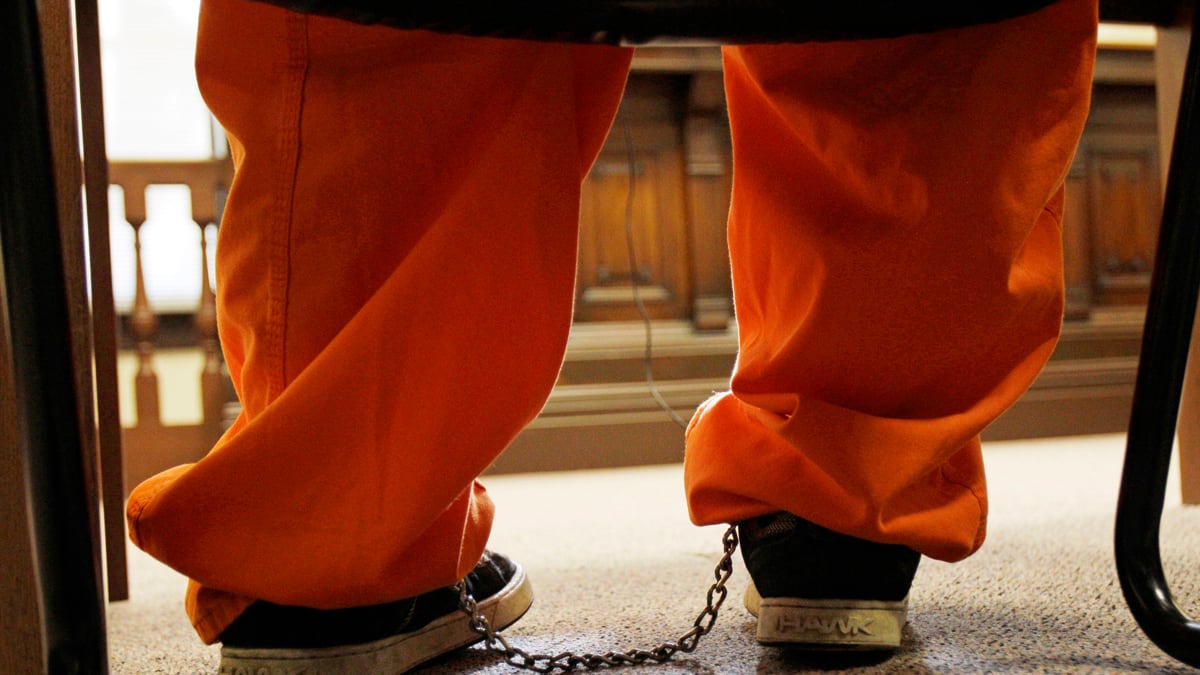You’re probably hearing a lot of hosannas today about the great significance of the Supreme Court’s ruling that mandatory life-without-parole sentences for juveniles are unconstitutional.
The highly respected SCOTUSblog analogized the ruling to cases categorically striking down the death penalty for juveniles, or prohibiting life sentences for nonhomicide crimes.
Similarly, the Equal Justice Initiative (which represented one of the petitioners and can therefore be forgiven for its exuberance) characterized the ruling as historic.
But don’t be fooled: the court on Monday squandered a real opportunity. In a tepid and narrow ruling, it threw a chicken bone to the petitioners in the two combined cases—Kutrell Jackson and Evan Miller—as well as around two thousand other prisoners in similar situations. But it failed to do anything morally important. Its decision embodies incrementalism at its very worst.
Before we get to the opinions, let's be clear about the horrific crimes involved. This is what Jackson did: When he was 14, he and two others attempted to rob an Arkansas video store. Jackson knew one of the others, Derrick Shields, was carrying a shotgun. Shields shot and killed Laurie Troup, the clerk at the store.
Miller's crime, which took place in Alabama, was probably even worse. He and his friend Colby Smith smoked marijuana and drank with a man named Cole Cannon, who had made a drug deal earlier that evening with Miller's mom. After Cannon passed out, Miller stole his wallet and removed the money. When Cannon woke up and grabbed Miller, Smith hit Cannon with a bat. Miller then picked up the bat and beat Cannon repeatedly. While Cannon lay unconscious, Miller and Smith set the trailer on fire; Cannon died from his injuries and smoke inhalation.

Both Miller and Jackson were sentenced to life in prison without the possibility of parole. They became two of more than 40,000 people in the United States serving such sentences, known in legal circles as LWOP. Two thousand five hundred of those inmates were under the age of 18 at the time they committed the crime that resulted in their sentence.
Yesterday's 5-to-4 decision will help around 80 percent of those juveniles, but by help, I do not mean to suggest the juveniles will not in fact die in prison. They very well might.
Why? Because the court in Miller and Jackson did not rule that LWOP is necessarily unconstitutional when applied to someone who commits a crime prior to age 18. It merely held that any state law imposing mandatory LWOP for juveniles violates the Eighth Amendment’s ban on cruel and unusual punishment. So, for instance, it would still be OK for a jury to sentence Jackson or Miller, or any 14-year-old, to life in prison without the possibility of parole, as long as the jury has the option not to issue that sentence. You have to have awfully low standards to think this decision marks much by way of progress when it comes to criminal punishment.
To see just how picayune the debate got, take a look at the opinions. Justice Kagan wrote the majority opinion. Chief Justice Roberts wrote one of three dissents, along with Justices Thomas and Alito. Roberts and Kagan did not disagree about the neuroscience, which clearly shows that juvenile brains are different from those of adults, but they did argue a great deal about the salience of certain statistics. For example, what should be made of the fact that Alabama and Arkansas—whose laws were at issue in these cases—are two of 29 jurisdictions that permit mandatory LWOP for juveniles? Roberts thinks it means most states believe LWOP for juveniles is warranted. Kagan disagrees; she does not think this scorecard proves that most states have thoughtfully decided that mandatory LWOP is an appropriate punishment for juveniles.
More significantly, perhaps, Roberts argued the sheer number of juveniles serving LWOP proves the punishment is constitutional. Kagan responded that 85 percent of the juvenile LWOP sentences come from jurisdictions where the sentence is mandatory. In other words, she concluded, when juries have discretion, they choose not to sentence juveniles to LWOP.
About now you might be asking: Why does any of this even matter? To someone unfamiliar with the court's twisted Eighth Amendment jurisprudence, the wrangling over the meaning of statistics looks not only like tea-leaf reading, but tea-leaf reading that has absolutely nothing to do with what the court is supposed to be doing. The court's job is to say what the Constitution means, and that isn't supposed to have anything to do with what we want it to mean, or even with what the states think it means. If LWOP for juveniles is unconstitutional, it's unconstitutional regardless of whether there are two juveniles or 2,000 who are affected. You can be sure that when the court issues its ruling on the health-care act this Thursday, it won't consider popular opinion regarding the law relevant to its decision.
But the Eighth Amendment is different. Ever since the Supreme Court decided Trop v. Dulles in 1958, the court has accepted the idea that the "cruel and unusual punishment" clause embodies the "evolving standards of decency that mark the progress of a maturing society." Consequently, nearly everyone on the court believes that a punishment can become unconstitutional, even if it was permissible 200 years ago. The trick is in figuring out whether it has, and in performing that piece of analysis, the court has looked to what the people actually think.
Kagan identified two relevant lines of cases that have parsed the meaning of our evolving standards of decency. In one, the court has ruled that certain classes of people are absolutely immune from certain punishments. So, for example, the court has held that the states cannot execute people who are mentally retarded or who were under the age of 18 when they committed a homicide. In a second class of cases, the court has insisted that juries consider the individual characteristics of the offender before imposing a punishment. States cannot automatically sentence someone to death if he commits a certain crime; a jury has to have the chance to spare his life. Examining both these strands together, the court concluded that evolving standards of decency prevent a state from mandating that juveniles be sentenced to life without parole.
But Roberts took stock of an entirely different development. In the mid 1980s, he noted, America’s criminal justice system all but abandoned the rehabilitative ideal. State legislatures adopted an approach we can refer to as "lock 'em up and throw away the key." The proof is not only the absence of rehabilitative programs in prisons, but the simple fact that 40,000 people in the U.S. are serving life without parole.
Roberts viewed the number of juveniles serving LWOP as perfectly consistent with this fundamental shift in the philosophy of punishment—and he is absolutely right. The majority, and especially Justice Breyer, who wrote a separate concurring opinion, stressed the indisputable psychological and neuroscientific fact that juvenile brains differ from those of adults. But nobody was disagreeing with them. For Roberts and company, it is up to legislatures to decide whether those differences matter, and insofar as the contemporary incarceration culture is entirely indifferent to the possibility of reform or change, their answer is that they don't. The majority had an opportunity to reply to that argument. It didn't.
What the majority could have said is that there are unquestionably certain bad guys who are so deeply and inveterately bad they should be spend the rest of their lives in prison—both because that is what they deserve, and because there is no other way to keep society safe. But to say there is even a single 12-year-old, or a single 14-year-old, who warrants such punishment, is scientifically and morally indefensible. That society has given up on the very idea of rehabilitation does not mean that the surrender is not cruel and unusual. The court in Miller and Jackson had an opportunity to say just that. It didn't.
I suspect the court opted for incrementalism in part because that is what was required to muster five votes, and in part because it is hard to draw lines. If a 17-year-old is capable of rehabilitation, what about a 19-year-old? How about a 20-year-old? There is a principled answer to this conundrum: LWOP is never appropriate. None of us is God, so we can never say what an individual will become or how he might change. That's why we have parole boards.
It's true that some thugs will never change, and parole boards can deny them parole every time their number comes up. But it is equally true that many people who commit horrific crimes do in fact change profoundly, and mandating that they die in prison anyway is cruel in any meaningful sense of the word.
The lawyers who represented Kutrell Miller and Even Jackson served their clients well, but the Supreme Court majority let down the future Millers and Jacksons who might now receive exactly the same punishment, so long as their juries jump through certain hoops before imposing it.
The Eighth Amendment, however, is not supposed to be a mere checklist. It is supposed to be a constitutional command with deep moral content. Monday’s decision evaded that content, and by so doing it allowed an immoral punishment to survive.






